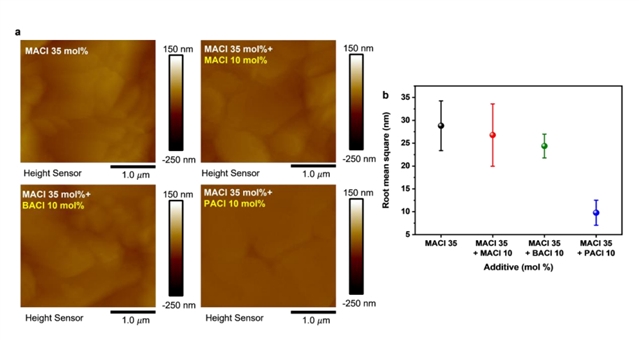
韩国蔚山国立科学技术学院Seok, Sang Il团队报道了用挥发性烷基胺氯化物控制钙钛矿层的生长。相关研究成果发表在2023年2月16日出版的《自然》。
通过溶剂工程和甲基氯化铵添加等方法控制钙钛矿层的结晶度和表面形态是实现高效钙钛矿太阳能电池(PSCs)的有效策略。特别是,沉积具有较少缺陷的α-甲胺化碘化铅(FAPbI3)钙钛矿薄膜至关重要,因为其具有优异的结晶度和大的晶粒尺寸。
该文中,研究人员报道了添加到FAPbI3中的烷基氯化铵(RACl)的组合对钙钛矿薄膜的控制结晶。通过原位掠入射广角X射线衍射和扫描电子显微镜研究了FAPbI3的δ-到α-相变以及在不同条件下涂覆RACl的钙钛矿薄膜的结晶过程和表面形貌。添加到前体溶液中的RACl被认为在涂覆和退火过程中容易挥发,这是由于RA···H+-Cl-与FAPbI3中的PbI2结合导致RA+脱质子化,从而解离成RA0和HCl。因此,RACl的类型和量决定了最终α-FAPbI3的δ-到α-相变速率、结晶度、优选取向和表面形态。所得钙钛矿薄层有助于在标准照明下制造功率转换效率为26.08%(经认证为25.73%)的PSCs。
附:英文原文
Title: Controlled growth of perovskite layers with volatile alkylammonium chlorides
Author: Park, Jaewang, Kim, Jongbeom, Yun, Hyun-Sung, Paik, Min Jae, Noh, Eunseo, Mun, Hyun Jung, Kim, Min Gyu, Shin, Tae Joo, Seok, Sang Il
Issue&Volume: 2023-02-16
Abstract: Controlling the crystallinity and surface morphology of the perovskite layers by methods such as solvent engineering1,2 and methylammonium chloride addition3-7 is an effective strategy for achieving high-efficiency perovskite solar cells (PSCs). In particular, it is essential to deposit an α-formamidinium lead iodide (FAPbI3) perovskite thin films with fewer defects due to their excellent crystallinity and large grain size. Herein, we report the controlled crystallisation of perovskite thin films with the combination of alkylammonium chlorides (RACl) added to FAPbI3. The δ- to α-phase transition of FAPbI3 and the crystallisation process and surface morphology of the perovskite thin films coated with RACl under various conditions were investigated through in situ grazing incident wide-angle X-ray diffraction and scanning electron microscopy. RACl added to the precursor solution was believed to be easily volatilised during coating and annealing owing to dissociation into RA0 and HCl with deprotonation of RA+ induced by RA···H+-Cl- binding to PbI2 in FAPbI3. Thus, the type and amount of RACl determined the δ- to α-phase transition rate, crystallinity, preferred orientation, and surface morphology of the final α-FAPbI3. The resulting perovskite thin layers facilitated the fabrication of PSCs with a power conversion efficiency of 26.08% (certified 25.73%) under standard illumination.
DOI: 10.1038/s41586-023-05825-y
Source: https://www.nature.com/articles/s41586-023-05825-y
官方网址:http://www.nature.com/
